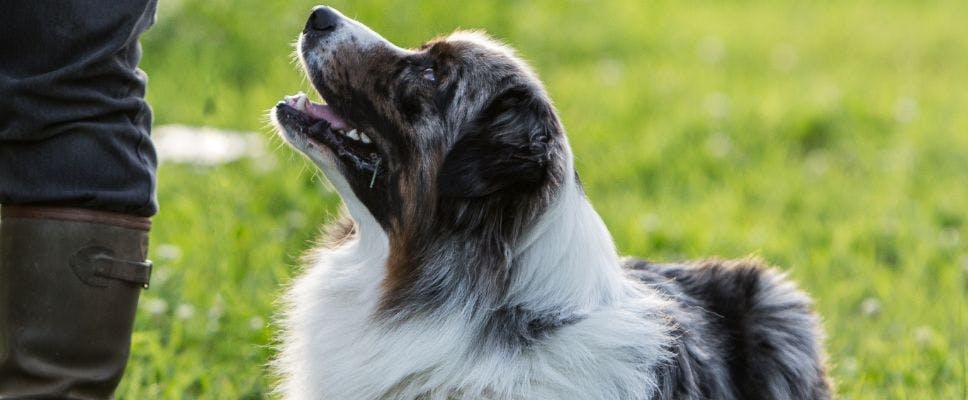
Working out how to train your dog simple commands is a straightforward process that requires consistency and commitment. Dogs don’t speak our language, but we can set up methods and tools to communicate effectively with our intelligent best friends.
Learn how to train your dog to do basic commands with a professional trainer or program that suits your needs. Here are some of the fundamentals:
- Marker and release words
- Come when called (Recall)
- Sit
- Drop
- Stand
- Stay
Getting started on training your dog

Before getting straight into the training commands, you first need to ensure your dog is engaged and establish a clear way of communicating.
What you need to know about bridging words
A ‘Marker’ word you use to mark or communicate to your dog that a reward will follow their action. It provides clarity for your dog that goes beyond language. Your dog may not speak human, but you can clearly communicate with your dog with cues.
Most owners unknowingly use a marker word or phrase – for example, as soon as the dog sits, there is often a follow up from the owner saying, “good dog”, then perhaps deliver a friendly big hug or pat. The dog then learns “good dog” equals a reward and therefore starts to modify their behaviour to hear the phrase more often.
It’s up to you what word you use as your marker word, but it’s a good idea to make it one syllable to be quick and consistent in delivery. At Petstock’s Puppy School, the word ‘yes’ is recommended and used. You can use a clicker tool as the marker too.
Try it! Practice using the marker word: Every time your dog looks at you, say “yes”, then deliver a treat. Practice this ten times in quick succession. This is how we condition a dog to the word. This will improve engagement, and your dog will start looking at you more frequently – this is a success! Now, every time your dog does something you have taught, use that word, followed by a reward, or if your dog exhibits a behaviour you want, mark with a “yes” and reward.
What you need to know about a release word
Like a marker word, a release word is a cue for your dog. It marks that an exercise is over, and your dog is free to move on. A release word is often an excellent tool for exercises like stay, where you need a clear cue to let your dog know they are free from your last instruction. A release word helps avoid a marker being confused as a cue for the end of an exercise. Commonly used release words – “free”, “ok” and “good”.
A release word adds an extra layer to your communication bank to distinguish when a command is over. For example, if you treat your dog after a sit and your dog immediately moves from the sit position afterwards, they associate the treat and marker as freedom from the command. Not everyone will use this word in their training toolkit; however, it is recommended for further control and clarity for your dog.
At Petstock Puppy School we focus on reward-based training. Read more information on the styles of training techniques and theory.
How to train your dog basic commands
Once you have the right communication tools in place, you can start exploring how to train your dog basic or simple commands. We refer to the standard obedience fundamentals taught in puppy school when talking about basic commands.
Learning the exercises of recall/sit/drop/stand will prepare your dog in the best way for many life instances, including having off-leash control, vet or grooming visits and emergency distance commands.
At Petstock, we recommend enrolling your dog or puppy in training classes to take these learning steps alongside a qualified professional. Being able to pick up on dog behaviour cues, human error, and timing issues is simpler with someone to guide you.
Petstock offers Puppy Pre-School, Level 1, and Level 2 classes, along with private lessons in store or home visits for puppies and dogs of all ages. classes, along with private lessons in store or home visits for puppies and dogs of all ages.
How to train your dog to sit
All the exercises below start with a lure, which is temporary. It is preferred that treats be your dog’s reward, rather than a bribe (which is the case of a lure).

Training your dog to sit is one of the first obedience commands taught in training schools. It’s a key command that sets your dog up for success in all areas of life.
Step-by-step:
- With a treat in your hand, lure your pup’s head upwards in slow motion.
- Your pup’s head should always follow the treat. As soon as your pup’s backside touches the ground, reinforce with the treat and lots of praise.
- Slowly you can remove the lure by removing your hand upwards (without the treat) while you are standing. Your dog should fall into a sit position.
- Once you’re at this stage, you can add a verbal cue of “sit”, followed by the hand signal. When your dog sits, mark and reward.
- You can also capture a sit by saying the word “sit” and reinforcing whenever your pup naturally falls into the sit position.
How to train your dog to recall
Recall training is a very important exercise and can be taught quite easily. It’s a useful exercise to teach your dog, especially when visiting high traffic areas like parks and beaches.
Step-by-step:
- Have your dog on a lead, and some tasty high value treats in your hand.
- While your pup is exploring the area around you, say their name, and when they look at you, present them a treat.
- As your dog comes towards you to investigate what is in your hand, say “come” or “here”, then mark and reward when they reach your hand.
- You can also take a few steps backwards and, as your pup follows, say “come” or “here”, then mark and reward.
- Always start on a short lead, and as they begin to understand the exercise, you can then move to a long lead or try it off-lead at home.
How to train your dog to drop
Step-by-step:
- This exercise can be taught with your dog in a sit or stand position.
- Now, with your hand and treat near your pup’s nose and palm facing the dog, slowly lure your pup’s head straight down. Make sure your pup’s head is going down with the lure.
- Just remember, every dog is different, so your angle might vary slightly but should always be downwards.
- As soon as our pup falls into a drop position, reinforce with the treat and lots of praise.
How to train your dog to stand
Step-by-step:
- Start with your dog in a sit or drop position for this exercise.
- Lure your dog from a drop or sit position into a stand position by pulling the lure straight away from the pup's muzzle slowly at a 45% angle.
- The dog's nose must always be following the treatment, and as soon as the dog stands up, say "yes" and reward with a treat.
- Slowly you can relax the lure by just moving your hand forwards. The dog should lure straight into a stand. Mark, reward, and praise! Practise many times until your dog can stand by just a hand signal (no treat in your hand).
- Now you can start assigning the verbal cue "stand". Say "stand", and now use your hand signal. Ensure you say "stand" first, then use your hand signal, never at the same time. Keep repeating until your dog stands before you give the hand signal. Now you have a verbal "stand".
- Once your dog has mastered the stand, you can start varying the duration that your dog has to hold the stand position before they hear their release/marker word. You may ask your dog to stand for five seconds, where you then release by saying "yes" and delivering a tasty treat. Make the duration unpredictable each time.
How to train your dog to stay
Technically, you don't need to put a dog into a "stay" cue as the dog has been taught to hold a sit, no matter what, so that is effectively a stay. However, it can be good to add in for when you're moving away from the dog.
Step-by-step:
- First, ask your dog to sit and ensure they are nice and focused!
- Now say "stay" and use a hand signal (flat palm facing the dog). Now put your arms back to the side.
- Take one small step backwards (a very tiny step), return to your dog. Now use your marker word "yes" and give your dog a tasty treat. Repeat a few times and only release your dog from a stay with the release word. This will teach them not to run off once they have received a treat.
- Keep repeating, altering duration and distance, and keep it unpredictable. Don't always release your dog at the same position or same time, and always start extremely small. You don't want the dog breaking the stay. If they do, you are going too fast, so remember to slow down and make it easier.
- Once you are confident now you can start adding in distractions. Get your dog to stay whilst on a walk, in various spots. You may also want to have some fun with it by getting your dog to stay while you do some push-ups, for example.
When to start training your dog

When should you start training your dog? Well, as soon as you can! The great thing about training is any dog of any breed or age can pick this up relatively quickly with a bit of patience. You can start this training as soon as you bring your new puppy or your newly adopted pooch home. Even if you already have a dog, there is no time like the present to get started.
How long does it take to train a dog on simple commands?
It is super important to stay patient! If you ever feel too frustrated during training, end the session right away and come back later when you are fresh.
It’s also important to note you only need to do short sessions of 5-10 minutes. You want to keep the training sessions short and fun to keep your dog engaged. If you do multiple short sessions each day, you’ll have a nice “sit”, “stay”, and “stand” within a few days!
Remember, you must then train your dog to execute these behaviours in all environments and scenarios. This also takes time. An easy way to do this is to stop multiple times on your daily walk and practise your behaviours. The benefit here is that your dog is always practising in different environments.
Now you’ve got some of the simple and basic down pat, keep pushing and learning – as your dog will enjoy working with you and appreciate consistent communication.
For more information on PETstock training services, click here.
Keen to know more about dog training and behaviour? Keep reading the Pet Smarts blog for everything dogs and puppies.